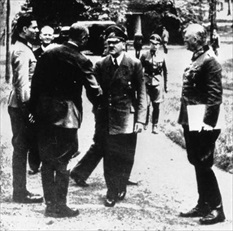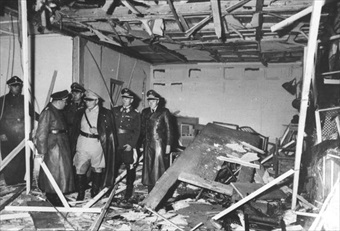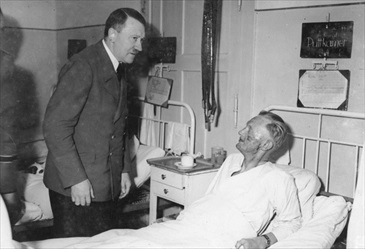HITLER ESCAPES ASSASSIN’S BOMB
Berlin, Germany · March 21, 1943
Adolf Hitler was the target of assassins on at least 30 occasions. On this date in 1943 in Berlin, German army officers made the second of two attempts in March to kill Hitler with a bomb. The week before, two staff officers had planted a bomb aboard Hitler’s private plane. The plastic explosives were contained in a package supposedly containing bottles of brandy for a member of Hitler’s staff at the Wolfsschanze (“Wolf’s Lair”), Hitler’s remote, high-security command post at Rastenburg in East Prussia. (Rastenburg, now called Kętrzyn, is in today’s Poland.) The detonator failed to go off. In the March 21 attempt, Hitler left the exhibition hall showcasing captured Soviet war booty before the bomb could go off. The officer on the suicide mission flushed the detonator down the toilet in a men’s room. Eight months later, in November 1943, a young army officer volunteered to blow himself up while modeling a new military greatcoat in front of Hitler, only to learn that Hitler had cancelled the meeting.
By the summer of 1944 some senior figures in the Wehrmacht (German military) despaired that Hitler was dooming Germany to defeat on both the Eastern and Western fronts, and that the Western powers at least might be open to negotiate a conditional German surrender once Hitler was gone. From this belief the July 20, 1944, bomb plot, codenamed “Valkyrie” (German, “Walkuere”) developed. Plotters included Adm. Wilhelm Canaris, the 57-year-old head of the Abwehr (military intelligence); retired Col. Gen. Ludwig Beck, whom the plotters tapped to succeed Hitler as the new head of state; Maj. Gen. Baron Henning von Tresckow, who had been involved in the brandy bottles plot; and 37‑year-old Col. Claus von Stauffenberg, Chief of Staff Army Reserve.
The key figure in the July 1944 plot was Stauffenberg. Of all the plotters he was in regular contact with Hitler and could get into Wolf’s Lair with few problems. Stauffenberg’s bomb-stuffed briefcase, which he had placed under a table before leaving the conference room to supposedly take a phone call, exploded, dazing and wounding Hitler and killing four of the 24 people in the room. Back in Berlin, Stauffenberg and three conspirators were executed the same day for their roles in the attempted assassination, the first of upwards of 5,000 people who were eventually implicated (many falsely) and killed; others were sent to concentration camps. Hitler made sure personally of Stauffenberg’s death by having his body exhumed to view it for himself.
Operation Valkyrie, the Failed July 20, 1944, Bomb Plot to Kill Adolf Hitler
 |  |
Left: Col. Claus von Stauffenberg (far left), Hitler, and Wilhelm Keitel (right), chief of the Oberkommando der Wehrmacht (OKW), or Supreme Command of the Armed Forces, on the day of a failed assassination attempt at the Wolf’s Lair in Rastenburg (Kętrzyn, Poland) on July 15, 1944. Officers in the Wehrmacht and the Abwehr, knowing well the string of failures to eliminate Hitler and his regime, nonetheless remained convinced that only they were capable of getting close enough to the well-guarded Fuehrer to do the deed.
![]()
Right: Wolf’s Lair conference room soon after the explosion. Showing visitors the damaged room is Reichsmarschall and Luftwaffe chief Hermann Goering in the khaki uniform.
 |  |
Left: Hitler making a hospital call on Adm. Karl-Jesko von Puttkamer, a victim of the July 1944 bombing. Eleven men were badly injured by the blast. Hitler was lucky and suffered only a broken eardrum.
![]()
Right: Tenth anniversary stamp memorializing the failed assassination of Hitler in July 1944. Pictured on the stamp is Richard Scheibe’s statue “Memorial to the Victims of July 20, 1944,” which stands in the courtyard of the Bendlerblock, site of Stauffenberg’s execution. The Bendlerblock was used by several departments of the Oberkommando der Wehrmacht, including Adm. Canaris’ Abwehr. Today the building complex serves as a secondary seat of the German Federal Ministry of Defense.
History Channel’s Operation Valkyrie: The Plot to Kill Adolf Hitler
![]()

 History buffs, there is good news! The Daily Chronicles of World War II is now available as an ebook for $4.99 on Amazon.com. Containing a year’s worth of dated entries from this website, the ebook brings the story of this tumultuous era to life in a compelling, authoritative, and succinct manner. Featuring inventive navigation aids, the ebook enables readers to instantly move forward or backward by month and date to different dated entries. Simple and elegant! Click
History buffs, there is good news! The Daily Chronicles of World War II is now available as an ebook for $4.99 on Amazon.com. Containing a year’s worth of dated entries from this website, the ebook brings the story of this tumultuous era to life in a compelling, authoritative, and succinct manner. Featuring inventive navigation aids, the ebook enables readers to instantly move forward or backward by month and date to different dated entries. Simple and elegant! Click 











